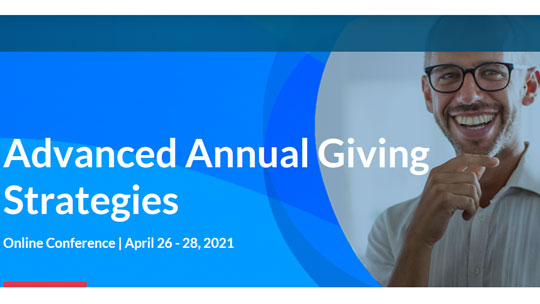fundraising
5 Things I Learned at CASE Advanced Annual Giving Strategies
The CASE Advanced Annual Giving conferences just wrapped up and I was lucky enough to be on the faculty of Advanced Annual Giving this year. It was great to join a great group of advancement leaders in these important conversations about how we engage donors. Here are my key takeaways.
Giving days are a top focus

The vast majority (85%) of attendees said they had an active giving day. The debate about the power of these events is over, and people are now talking about “what’s next.”
- There are institutions that felt significant pain when their giving days were put on hold at the start of the pandemic last year. But many kept their giving days on the same or a delayed date and saw great success.
- The discussion of giving day donor retention was mixed. Some institutions reported very high giving day donor retention, particularly when using integrated technology such as web pages, social, video, texting, and email.
- There is substantial concern that we’re falling into the trap of trying to “one up” the previous year’s results. How big can these events go, amplified by major gifts?
- Everyone pretty much agrees that volunteer ambassadors are highly effective and an area for growth.
My take: Ambassador engagement and embracing easy giving vehicles like a digital wallet that accepts Paypal, Venmo and Apple Pay are your two best giving day investments for the coming year. If you’re looking to benchmark your program, here’s $400M in results for you to nerd out on.
Everyone wants to talk about “phonathon”
I led a conversation with Stanford, University of Cincinnati, and Stony Brook University about the future of our student engagement ambassador programs (that thing we used to call “phonathon”). Some takeaways:
- There was pretty good agreement that student engagement with donors is worth it, but we should all be moving past just calling.
- Everyone is using or working on implementing some form of texting engagement.
- Video messaging (through great platforms like ThankView) is being widely adopted.
- There is growing use of actionable analytics to target efforts.
My take: Use more than one channel, base it on data, and move beyond the annual fund. The outreach that student ambassadors do has incredible value, but it’s time to level up our engagement. I broke down RNL’s Digital Engagement Center strategy in a Lightning Talk with Shad Hanselman. We discussed how coordinated phone, texting, personalized video and advanced analytics can help you retire your tired “phonathon” and get a lot more from your effort.
ROI conversations and shifting expectations dominate
It’s been a rough year, and while many institutions set records for giving, budgets are crunched. Things I heard:
- Should we have giving societies? What should the leadership giving level be?
- My budget was cut, but my expectations weren’t.
- My IT team won’t let me do [insert new thing].
- Yes, I know that this has enormous long-term value, but I just can’t pay for it today.
I’ve heard all these things in the past, but I think the stress of the pandemic has really increased something I’m worried about in advancement:
I’ll make the bold statement that about half of what we in our jobs do has nothing to do with donor engagement or the giving experience. I call these “fundraiser-facing concerns.” This includes everything from “my boss said we should do this,” to “I can’t do that because of the budget structure.”
My take: If we don’t spend more time on the donor experience and less time on what the peanut gallery has to say about our strategies and what we can’t do, the massive, 40-year decline in alumni participation will continue. Americans are giving. We need to face up that fewer of them are giving to their alma mater. Let’s spend less time on “fundraiser facing” and more time on “donor-facing” priorities.
My best conversation discussed diversity
Our national conversation about inclusion, equity, and social justice is a significant part of fundraising conversations right now.
- It’s clear that many donors want to give to support social justice.
- There are also donors who don’t want us to spend resources on these efforts.
- If you’re going to solicit for diversity efforts, you better have a real effort to fund.
- The names of our buildings, what statues stay up, and how leadership responds to key diversity issues matters.
- I continue to hear alarming things about how student ambassadors are treated regarding diversity when they talk to donors.
My take: It’s very clear that our institutions and our fundraising are a locus of the important national discussion on these issues. I learned a lot from leaders on some recent podcasts I recorded on these issues. We have work to do.
Remote work sometimes includes goats and cats
Virtual conferences are both weird and awesome. It’s great to connect with people I love seeing every spring, even it’s through a Zoom screen. It’s also really hard to encourage group conversation, participation, and interaction. And there are always some surprises. One session I led was joined by two different cats on screen. In another, one of our faculty members needed to excuse themselves because their baby goat had wandered into the street and the neighbors called.
This conference was great and I was honored to be on the faculty. I’m looking forward to having some in-person conferences when it’s safe, but CASE is working hard to fill the gap with quality, virtual events, and passing on the reduced costs to members. Check out upcoming CASE events, and join us in a few months for the 2021 Advancement Innovation Summit.
You can even bring your goat (virtually).
2021 RNL Virtual Advancement Innovation Summit
Watch every session from the the 2021 RNL Advancement Innovation Summit free. Topics include:
- Digital engagement and digital giving
- Alumni and donor engagement
- Remote management of fundraising operations
- Strategic optimization of donor engagement channels

